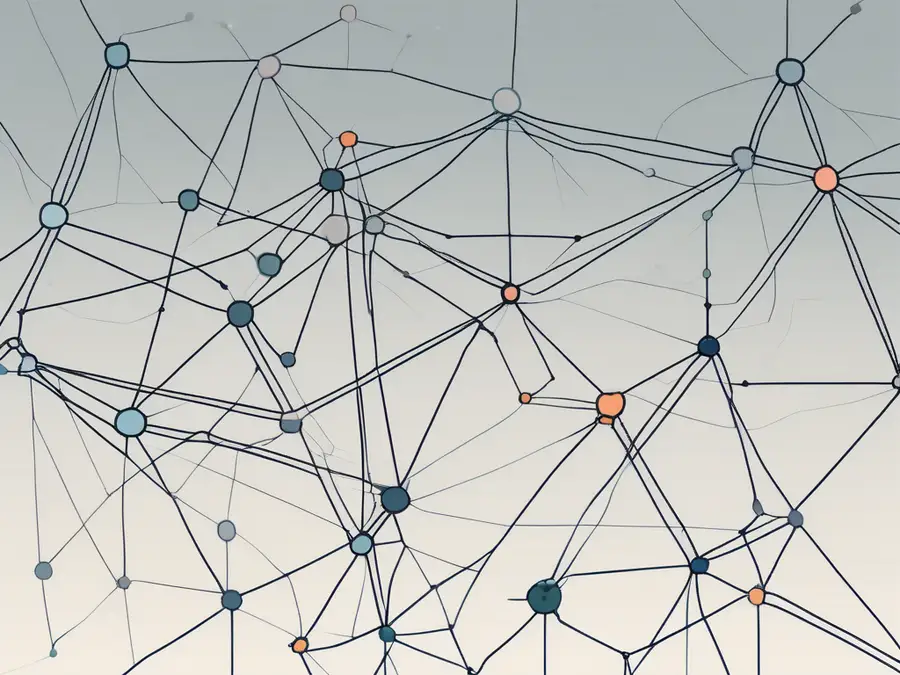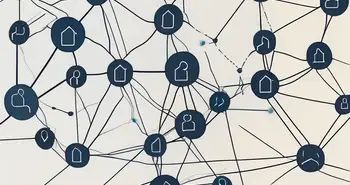The Power of Decentralized Identity

Decentralized identity is revolutionizing the way we interact with the digital world. In this comprehensive guide, I will walk you through the concept, benefits, technology, and implementation of decentralized identity. Strap in, because we're about to dive deep into the power of decentralized identity.
Understanding Decentralized Identity
The Concept of Decentralized Identity
Decentralized identity is a groundbreaking paradigm that shifts the control and ownership of personal data from centralized authorities to individuals themselves. It enables users to manage their identity and digital credentials independently, while maintaining privacy and security.
Imagine a world where you have complete control over your identity, where you can share your data selectively and revoke access at any time. That's the promise of decentralized identity.
The Evolution of Identity Verification
Traditional identity verification methods have long relied on central entities like governments and corporations to validate and authenticate individuals. However, this approach has its drawbacks, such as the risk of data breaches and the lack of user control.
Decentralized identity introduces a paradigm shift by leveraging cutting-edge technologies like blockchain and cryptography to enable secure, privacy-preserving identity verification. It eliminates the need for intermediaries, putting individuals in charge of their digital identity.
Key Components of Decentralized Identity
Decentralized identity comprises several key components that work together to create a robust and user-centric identity system.
- Decentralized Identifiers (DIDs): DIDs are unique identifiers that serve as the foundation of decentralized identity. They allow individuals to establish and manage their digital identity across different platforms and services.
- Verifiable Credentials: Verifiable credentials are cryptographic proofs issued by trusted entities that validate specific attributes or claims about an individual. They enable users to present trustworthy information without revealing unnecessary personal data.
- Identity Hubs: Identity hubs provide a secure place for individuals to store and manage their verifiable credentials. These hubs enable cryptographic operations and ensure data privacy and security.
The Benefits of Decentralized Identity
Enhancing Privacy and Security
Privacy and security are paramount in today's digital landscape. With centralized identity systems, personal information is vulnerable to data breaches and misuse. Decentralized identity offers a solution by putting users in control of their data. Users can selectively share information, reducing the risk of unauthorized access.
Imagine going to a doctor's office where you share only the necessary medical information, without exposing your entire medical history. Decentralized identity ensures your privacy is protected without compromising the integrity of the information being shared.
Empowering User Control and Consent
Decentralized identity empowers individuals by giving them full control over their digital selves. Users can decide which attributes and credentials to share, who can access them, and for how long. Consent becomes an integral part of the identity ecosystem, ensuring that individuals have the final say in how their data is used.
As an expert in decentralized identity, I have personally experienced the freedom and empowerment that come with being in control of my digital identity. It allows me to navigate the digital world without compromising my privacy or autonomy.
Facilitating Trust and Transparency
Trust is the foundation of any successful interaction, both online and offline. Decentralized identity fosters trust by enabling the verification of claims in a secure and tamper-resistant manner. With verifiable credentials, trust can be established without the need for exhaustive background checks and intermediaries.
Additionally, decentralized identity promotes transparency by providing individuals with a transparent record of who accessed their data and when. This accountability ensures that data is handled responsibly and ethically.
The Technology Behind Decentralized Identity
Blockchain and Decentralized Identity
Blockchain technology plays a crucial role in decentralized identity. Its inherent characteristics of immutability, transparency, and decentralization make it an ideal platform for storing and managing decentralized identities.
By leveraging blockchain, decentralized identity systems can ensure the integrity and security of verifiable credentials. They provide a tamper-proof and auditable record of identity-related transactions, enhancing trust and reliability.
Cryptography in Decentralized Identity
Cryptography forms the backbone of decentralized identity. It ensures privacy, security, and authenticity in identity verification processes. Public-key cryptography enables users to establish secure connections, sign and verify credentials, and protect sensitive information.
The beauty of cryptography lies in its ability to provide secure, privacy-preserving interactions while maintaining the seamless user experience we expect from digital platforms.
Decentralized Identifiers (DIDs)
Decentralized identifiers (DIDs) are the building blocks of decentralized identity. They are unique identifiers associated with individuals, organizations, devices, or entities. DIDs enable interoperability across different platforms and ensure that individuals maintain control and ownership of their digital identity.
As an expert in decentralized identity, I have witnessed the power of DIDs in action. They provide a universal language for identity verification, making it easier to navigate the vast digital landscape without compromising security or privacy.
Implementing Decentralized Identity
Steps to Adopt Decentralized Identity
Implementing decentralized identity requires a systematic approach. Here are the key steps to embark on this transformative journey:
- Educate and Raise Awareness: Start by understanding the principles and benefits of decentralized identity. Educate stakeholders and users about the potential impact it can have on privacy, security, and digital interactions.
- Collaborate and Standardize: Embrace collaboration and participate in standardization efforts. Engage with industry players, regulators, and organizations to establish common frameworks and interoperable solutions.
- Build and Test: Develop decentralized identity prototypes and pilot projects. Test the feasibility and usability of the solutions in real-world scenarios. Iterate and refine as needed.
- Scale and Integrate: Once the proof-of-concept phase is successful, focus on scaling the decentralized identity infrastructure. Integrate with existing systems, services, and platforms to maximize adoption and interoperability.
- Evaluate and Improve: Continuously evaluate the performance and impact of decentralized identity. Gather feedback from users and stakeholders, and make iterative improvements to address challenges and optimize the system.
Challenges in Implementation
Implementing decentralized identity comes with its own set of challenges. Some of the key hurdles include:
- User Adoption: Overcoming user resistance and facilitating the adoption of decentralized identity can be a daunting task. Education, awareness, and user-centered design play a crucial role in addressing this challenge.
- Interoperability: Ensuring interoperability between different decentralized identity systems and existing infrastructure is vital for widespread adoption. Collaboration and standardization efforts are essential to overcome this challenge.
- Regulatory Compliance: Navigating the legal and regulatory landscape poses challenges for decentralized identity implementation. Collaborating with regulators and policymakers can help create a conducive environment for adoption.
Future Trends in Decentralized Identity
As decentralized identity continues to evolve, several promising trends are on the horizon:
- Self-Sovereign Identity: Self-sovereign identity empowers individuals with complete control and ownership of their digital identities. This trend is gaining traction, and we can expect to see more self-sovereign identity solutions in the near future.
- Integration with Internet of Things (IoT): The convergence of decentralized identity and IoT opens up exciting possibilities. Imagine devices that can authenticate themselves securely and seamlessly interact with other devices or services.
- Decentralized Identity Wallets: Decentralized identity wallets are emerging as user-friendly solutions for managing and controlling digital identities. These wallets provide a seamless experience and enable individuals to carry their identities across different platforms.
Conclusion
Decentralized identity is a game-changer in the digital landscape. It empowers individuals, enhances privacy and security, and fosters trust and transparency. By leveraging blockchain, cryptography, and decentralized identifiers, we can build an identity system that puts users in control of their digital selves.
As an expert in decentralized identity, I have seen firsthand the transformative power of this technology. It revolutionizes the way we interact with the digital world, ensuring privacy, security, and user-centricity.
Decentralized Identity FAQ
What is decentralized identity?
Decentralized identity is a paradigm shift that puts individuals in control of their digital identity. It eliminates the need for centralized authorities and enables users to manage their identity and digital credentials independently.
Why is decentralized identity important?
Decentralized identity enhances privacy, security, and user control. It reduces the risk of data breaches, fosters trust, and empowers individuals to selectively share information.
What technologies are behind decentralized identity?
Decentralized identity leverages blockchain, cryptography, and decentralized identifiers (DIDs) to ensure privacy, security, and interoperability.
How can I implement decentralized identity?
To implement decentralized identity, start by educating stakeholders, collaborate and standardize, develop prototypes, scale the infrastructure, and continuously evaluate and improve the system.
What are the challenges in implementing decentralized identity?
The key challenges include user adoption, interoperability, and regulatory compliance. These challenges can be addressed through education, collaboration, and engagement with regulators.
What are the future trends in decentralized identity?
Some key future trends include self-sovereign identity, integration with IoT, and the rise of decentralized identity wallets for seamless identity management.
The power of decentralized identity is undeniable. It has the potential to reshape the way we engage with the digital world, putting individuals in control of their digital lives. Embrace the decentralized identity revolution, and unlock the full potential of a user-centric and privacy-preserving digital ecosystem.
As you embrace the decentralized identity revolution and take control of your digital life, why not extend that empowerment to your investments? Morpher.com offers a groundbreaking trading platform that aligns perfectly with the principles of self-sovereignty and user-centricity discussed in this guide. With Morpher, you can trade across multiple asset classes with zero fees, infinite liquidity, and the safety of a non-custodial wallet. Whether you're interested in fractional investing, short selling, or leveraging up to 10x, Morpher transforms your trading experience using the power of blockchain technology. Sign Up and Get Your Free Sign Up Bonus today, and join the community of traders who are reshaping the future of investing.

Disclaimer: All investments involve risk, and the past performance of a security, industry, sector, market, financial product, trading strategy, or individual’s trading does not guarantee future results or returns. Investors are fully responsible for any investment decisions they make. Such decisions should be based solely on an evaluation of their financial circumstances, investment objectives, risk tolerance, and liquidity needs. This post does not constitute investment advice.

Painless trading for everyone
Hundreds of markets all in one place - Apple, Bitcoin, Gold, Watches, NFTs, Sneakers and so much more.

Painless trading for everyone
Hundreds of markets all in one place - Apple, Bitcoin, Gold, Watches, NFTs, Sneakers and so much more.









